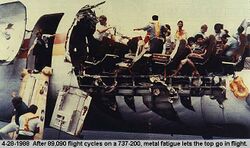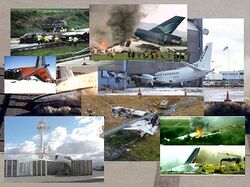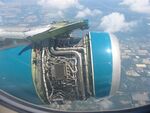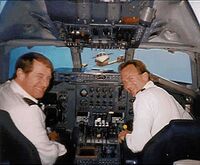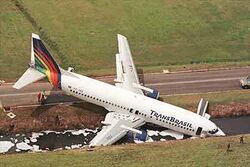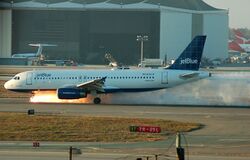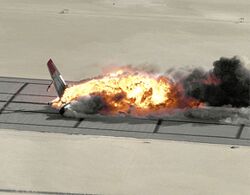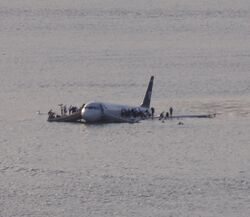HowTo:Overcome your fear of flying

|
HowTo This article is part of Uncyclopedia's HowTo series. See more HowTos |
Flying is one of the most common ways of traveling long distances in modern times. Although flying is very safe, some people are still afraid of flying. This guide is designed to help people overcome their fear of flying. Like cars, planes can have accidents from time to time. Unlike car accidents, however, which only kill a small number of people, plane crashes can kill hundreds of people, even more if it hits a building. It is commonly said that flying is safer than driving, although the National Transportation Safety Board (2006) reports 1.3 deaths per hundred million vehicle miles for travel by car, and 1.7 deaths per hundred million vehicle miles for travel by air.
Admitting you have a problem[edit]
The first step in overcoming your fear of flying is admit that you have a problem. Considering how safe flying is, it's not normal to be afraid of sitting in an enclosed tube, several miles in the air, at 500 mph, surrounded by a bunch of strangers. They say that driving to the airport is more dangerous than flying, but do you know anyone who has a fear of driving? Once you get over that, the best method to overcome your fear is to face it head on, like Air New Zealand Flight 901
Things that can happen on a plane[edit]

The main problem with many fears is the fear of the unknown. The following have been known to occur when flying:
What to expect[edit]
- You will be enclosed in the aircraft cabin
- The plane will fly very high
- You will not be in control of the plane, and sometimes the pilot isn't either. In fact, the plane may sometimes fly itself
- Panic attacks will be difficult and/or embarrassing (agoraphobia)
- Your plane may fly at night or over water
- Delays
- Lost luggage
- Lines for the bathroom
Your luggage[edit]
You can check some of your luggage in before getting on the flight (for a nominal fee, of course). This is good for large suitcases, and items that you won't be able to get through security (such as liquids, weapons, bombs, and dirty underwear). Your airline may let you take one or two bags on the plane as "carry-on" items. Keep in mind that airlines have been known to lose checked in luggage, so be prepared if you never see your bag(s) again. Should this happen, the airline may refund the $30 you paid to check it in.
If you have doubts, DON'T GET ON THE PLANE
Terrorists[edit]
Provided that the people at airport security are doing their job, terrorists and hijackers should not be a problem. Terrorists and hijackers attempt to take control and pilot it into buildings. They may or may not have a bomb on board. In most cases, terrorists can be identified by their middle-eastern appearances and constantly bowing down for "Allah" but careful as this is not always and the man may just be an ordinary Muslim. When in doubt, just assume that he/she is a terrorist.
Turbulence[edit]
Turbulence is a common occurrence when flying. This occurs when the plane gets blown around by winds in the atmosphere. Sit back, relax, and enjoy the ride, and watch your fellow passengers crash around the cabin. Turbulence can occur at any time, such as when flying through a storm cloud.
Bird strike[edit]
Due to most plane having to share airspace, there is the potential for the plane to collide with a bird during flight. In addition to collisions with the windshield, obstructing the pilot's view, birds can also be sucked into the engines, causing them to jam. In 1988 an Ethiopian Airlines Boeing 737 sucked pigeons into both engines during take-off and then crashed in an attempt to return to the Bahir Dar airport. Be wary if you see birds at the airport. You also need to be aware of other objects that could be around the plane, including helicopters, kites, and balloons
Ground damage[edit]
Sometimes air crashes are caused by damage sustained by the aircraft on the ground. There are many vehicles on the tarmac when the plane is at the gate, including the food trucks, luggage carts, jet-ways, and even other aircraft. If a driver makes a wrong move and hits the plane, a hole may appear in the plane, causing it to de-pressurize during flight. Keep a watch on those vehicles and make sure they don't come too close to the plane. If one look likes it's getting too close, or you see a crack or hole in the plane, notify the attendant at the gate.
Infection[edit]
On an airplane, hundreds of people sit in a confined space for extended periods of time, which increases the risk of transmission of airborne infections. For this reason, airlines place restrictions on the travel of passengers with known airborne contagious diseases (e.g. tuberculosis). In 2003, on one flight from Hong Kong to Beijing, 16 of 120 people on the flight developed proven SARS from a single initial case. To avoid getting infected, try not to sit around people who look like they are sick and wash your hands frequently.
Snakes[edit]
This guide is about overcoming your fear of flying, not your fear of snakes.
Fire[edit]
NEVER use a fire extinguisher as this will make the fire bigger. Instead use the largest flamethrower available, if possible. Otherwise see below. With all that jet fuel, the hidden electrical wiring, and people smoking in the lavatory, fires have been known to occur on civilian aircraft. Should a fire occur, or you smell smoke, use whatever you have available, such as that bottled water you were able to smuggle through security or your own bodily fluids, and return to your seat knowing you have done the best you could. Fires can lead to other disasters, including spontaneous in-flight explosions fueled by the compressed oxygen tanks.
Human error[edit]
Human error is one of the leading causes of airline incidents. If a pilot tries to ascend too quickly or takes a turn too steeply, the plane can enter a stall, which causes it to lose lift and plunge to the ground. Fortunately most, but not all, airliners have computer systems that prevent these kinds of incidents[1].
Choosing an airline[edit]
When it comes to flying, not all airlines are created equal. If you want to travel from Cincinnati to Los Angeles, there are several options. One is to travel by Greyhound, which can take a week or more, and taking a Greyhound bus can be an experience in itself. The main reason for flying, however, is that is is much faster than taking a bus. In this case, the best way to travel from Cincinnati to LA by plane may be via Qantas. This will require travelling to Melbourne, but this comes with the advantage in that Qantas planes never crash, though there is still a good chance of one of the engines disintegrating somewhere over Indonesia.
Another option is flying with JetBlue Airways, or JetBlue for short. While their safety record is not as impressive as Qantas', the freely available TVs, satellite radio, and Skymall catalog will distract you from the fact that the engines are held together with duct tape.
If flying with either JetBlue or Qantas turns out to be too expensive, or your destination is not served by them, consider other airlines. American Airlines and United Airlines, for example, are the airlines of choice for terrorists, with Delta being their third choice, though that flight was delayed. All three airlines are considered "Legacy" airlines, because they have been around longer, and are therefore more experienced.
Budget Airlines[edit]
Budget airlines have experienced a surge in popularity due to the economy and fuel prices. Budget airlines provide low fares by cutting back on some features, such as in-flight meals, pilot training, extra engines, safety inspections, fleet upgrades, complimentary peanuts, and people at the check in desks. If you want to be safe on a plane, pay extra for an airline that actually inspects its planes. One notable exception is Ryanair who instead covers costs by charging passengers extra for premium services, such as use of the restroom, oxygen masks, and flotation devices.
If you find a bomb on board, don't try to diffuse it yourself
Airport security[edit]
Airport security is the government's first line of defense against terrorists. In many cases this will mean having to remove all your clothes and walk through a metal detector and/or a body scanner (actually, you will not need to remove your clothes as the scanners will do that for you). TSA agents will be on-hand to check your baggage. The US Government recently discovered that terrorists could make bombs from water, so all liquids are banned from planes. This is all for your safety, and helps reduce the lines for the bathrooms on the plane. Be sure to ask the TSA officials if they have seen anyone carrying a bomb.
SSSS[edit]
SSSS is a method that the FAA uses to weed out potential terrorists. You may be unaware that your friend, mom, or child could be a terrorist. Fortunately, the airport security will pull them aside and prevent them from getting on the plane.
On the plane[edit]
Getting on the plane is a huge milestone in overcoming your fear of flying. Be sure to make yourself aware of the plane itself and be sure you know the locations and operating instructions of all the emergency exits. Check all the overheard compartments and under all the seats for any bombs that airport security may have missed. If you have any doubts about the safety of the flight, such as seeing people with middle-eastern appearances, ask to have them taken off the plane.
Bring a parachute with you on the plane.
The wings[edit]
The wings are what makes the plane fly. Look closely and you may see them wobble, just like a flapping bird. They usually have lights on them too, so that other planes don't crash into them, and flaps, which are useful for getting down in a hurry.
The engines[edit]
The engines are what propel the plane forward. Most planes have two or more engines and they usually hang from the wings. When one fails, the other(s) can take over, though it may take a bit longer to get to your destination. Should an engine fall off in flight, it should not matter too much, as the other engines take over and the reduced weight of the plane makes it easier to fly. If all the engines fail, the pilot may make an emergency landing, although usually the plane will just crash.
The bathrooms[edit]
The bathrooms of a plane are small, cramped, and usually have a line (and if you're flying with Ryanair, a fee). They are equipped with smoke detectors, so if you want to light up, don't do it in there. If there is a bomb on board, it may be hidden in the bathroom.
The cockpit[edit]
The cockpit is usually located at the front of the plane and this is where the pilot and co-pilot sit and drive the plane. There are two pilots so that if one of them gets food poisoning from eating fish, the other can fly the plane himself (unless you fly with Ryanair, in which case the head flight attendant will fly the plane instead). Should both pilots choose fish (or be attacked by terrorists), the autopilot will be able to fly, but hope that one of the other passengers on board knows how to land it, or ask the terrorists very nicely if they can land the plane in a safe area. Most pilots fly the plane by looking at their instruments, leaving the job of looking for mountains, towers, and other aircraft to the radar systems and air traffic control.
Choosing a seat[edit]
Most airlines allow passengers to choose a seat before boarding. First class seats are usually located at the front of the plane, and those passengers are most likely to die in the event of a crash. The cheapest seats are towards the back, and as such are the safest. There is great debate over whether window or aisle seats are better. The clear answer is an aisle seat. Aisle seats have the advantage in that you can easily get up and go to the bathroom, and are less likely to fall out of the plane in the case of explosive decompression. If you are seated in an exit row, make sure you know how to operate the emergency exit as you may need to use it in the event of a crash. Feel free to practice using it during the flight.
Your seat may be equipped with arm-rests and seat belt. The seat belt is designed to hold you in your seat during sudden impacts or decompression (however few people survive sudden impacts in a plane, with or without a seat belt). You may be asked to take on a "brace position", but the reason for this is so that more people die instead of suffering from life-long disabilities, resulting in lower long-term costs for the airline. Above your seat you will see controls for the fan, light, and a little red button that you should press if it looks like a wing is going to fall off, you hear a strange hissing sound from the window, or your bag of peanuts is empty. Also above your seat will be a compartment for oxygen masks. These serve multiple purposes, including allowing people to breath should the aircraft depressurize or the toilets back up.
In the seat pocket in front of you, you will find all the necessary items for flying. The most important is the safety card. In addition, you will probably find a barf bag, an empty bag of airplane peanuts left by the last passenger, the Skymall magazine, and the airline's magazine showcasing the movies that will be shown on that little screen several rows in front of you. The safety card will tell you about the make, model, and features of the plane you are flying in, such as how many bathrooms it has and the location of the nearest Bin Laden look alike. Make sure you study and memorize this card in the event that an emergency does occur.
Taxi[edit]
At this stage of the flight, the pilot must navigate the plane to the runway. The people up in the control tower will give the pilot directions to the run and keep an eye out to avoid collisions with other aircraft at the airport, which is what happened to KLM Flight 4805 and Pan Am Flight 1736. After taxiing, the plane will join the line for the runway, allowing each plane to take-off after the wake turbulence from the plane before it has died down to a safe level. At this point, the plane may taxi back to the gate (especially if you are flying with Delta) because of some mechanical difficulty discovered when running up the engines.
Takeoff[edit]
Congratulations on making it this far. The next step is to make sure you stay on the plane when it takes off. At this point, it is absolutely critical that you switch off all electronic devices, including cell phones, pacemakers, and iPods. If the person in seat 5B has their iPod turned on, do whatever it takes to make sure they turn it off. Even the slightest electrical current can completely throw off the plane's navigation system and send it hurtling towards the ground. It is almost absolutely certain that at least one child will start to scream at this time. This is completely normal.
Remote control cars[edit]
Once the plane is in the air, you can turn electronic devices back on, except for cell phones, remote control cars, and old radios. Remote control cars are not be used in flight because they can be a distraction to other passengers and pose a tripping hazard for the flight attendants.
During the flight[edit]
Try not to fall asleep during the flight. You may need to wake up in a hurry should there be a need to evacuate the plane
Airline food[edit]
Airline Food is a marvel of modern innovation. The flight attendants have the ability to serve hundreds of people in a matter of minutes, offering your choice of steak or fish. Drinks may or may not be offered, depending on much in fluids the flight attendants were able to smuggle through airport security. Upper class passengers may be offered alcoholic beverages.
Landings[edit]
The final part of the flight is the landing, and the point in the flight in which most accidents occur. When the plane lands, it slows down rapidly, flares, touches down, and then levels off. There are several types of ways a plane can land.
Airport landing[edit]
Airport landings are among the most common. When a plane flies, the landing gear (wheels) retract to make the plane more aerodynamic. Sometimes these wheels fail to fold back out, resulting in a "hard landing". For landing such as this, most airports have a fire department on hand to extinguish any fires that may break out during this time. After landing, the plane will make its way to the gate. Many airport landings are also accompanied by smoke and flames to add to the effect.
Crash landing[edit]
The second most common type of landing is the crash landing. In many cases crash landings are unintentional, but in some cases, they are intended. In most crash landings, people may die and such landings make the news when they occur.
Water landing[edit]
The opposite of a hard landing is a water landing. Planes are positively buoyant, like boats, and will float on water, until it starts to take on water and sink. Each seat cushion can be used as a flotation device and life jackets are available to add to the boating experience. In addition, each emergency exit is equipped with a giant inflatable slide that can be used as a raft. For your benefit, pack your swimming trunks in your carry-on luggage, as the flight crew may restrict access to the luggage compartment. Keep in mind that water landings can be rare, and wide-body jets are not capable of such a landing.
The Black Box[edit]
Every commercial aircraft has a Black Box. The Black Box is a box, and originally, it was black, although authorities decided years later that it might help investigators locate it if it were instead, say, red or orange. The Black Box helps keep passengers safe; because after your body becomes a small piece of crisp bacon, the Black Box may help the writing of a large report explaining why it happened. The Black Box is protected so that it will survive any sort of flight disaster, using technology that is somehow not available to protect the passengers themselves.
The Black Box records critical data during the flight, such as the exact location where the plane went down (Hint: It is very close to where you found the Black Box), the amount of fuel left on board, whether the pilot was trying to do anything cutesy such as point the plane straight up or straight down, and the number of people on board. The Black Box can also tell you how many of these were wearing business suits, versus Hawaiian shirts and flip-flops.
Returning to the topic of protecting passengers, engineers considered creating an entire plane out of the same material used for the Black Box, but this led to cost over-runs. In view of the competition they face, airlines stayed with hulls built of crumply tin, though they did spring to paint them in various cheerful colors.
Alternatives to flying[edit]
If worst comes to worst, there are some forms of transport that are safer than flying. These include
- Escalators
- Driving (but only on the driveway, in first gear, with no other cars around)
- Moving walkways
- Walking
- Trains
- Ships (though only outside the Bermuda Triangle)
Conclusion[edit]
After reading this guide, you should know about all there is to know about planes and flying, as well as what to do in emergency situations. There is really nothing to be afraid of. We hope you have a safe flight.
See also[edit]
| ||||||||||||||||||||||||||
